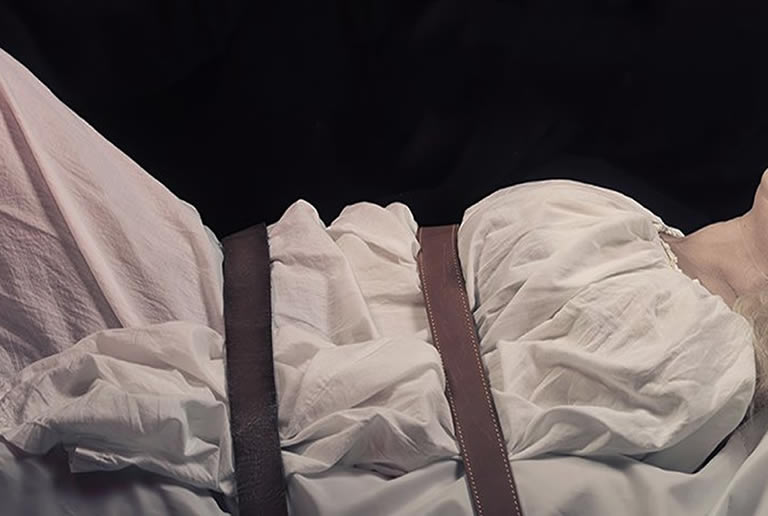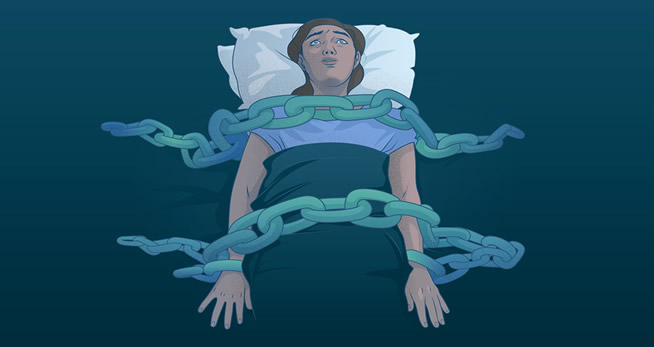
Lucid dreaming offers many benefits not just while sleeping but also long after you wake up. But, many people have legitimate concerns about what lucid dreaming can do to the mind and body of the dreamer. One such concern is sleep paralysis.
Contents
The Main Causes Of Sleep Paralysis
There are many people all over the world that experience sleep paralysis but what exactly is it, what causes it and how does it relate to lucid dreaming?
Sleep and wakefulness are usually two distinctly separate states of consciousness.
While asleep, most people are unconscious and unaware of their bodies and their surroundings.
Obviously the reverse is true when we are not sleeping.
When we are awake we are engaged with all our senses and are fully aware.
Sleep paralysis falls somewhere between the two.
With sleep paralysis there is a merging between the state of sleep and the sate of wakefulness that results in a state where our the body remains asleep while the mind is wide awake.
So how does this happen?

While we sleep and enter the state of REM (Rapid Eye Movement), where dreams occur.
During the REM state our bodies are paralyzed as a safety precaution.
By immobilizing all our muscles, except our eyes, we are prevented from acting out our dreams in the real world.
Only people who experience the parasomnia (sleep disorder) known as somnambulism, where they sleep walk while dreaming, do not experience this paralysis.
Muscle paralysis during sleep is a good thing.
Having your body totally immobilized while you dream is a very beneficial thing.
Imagine if you were to act out a nightmare where you were jumping off a building or killing someone?
This is a very real danger for people who suffer from somnambulism so be grateful that you do not suffer from this.
Problems only arise for most of us when we experience this paralyzed bodily state while our mind enters the state of wakefulness.
During the state of dreaming when bodily paralysis occurs this paralysis is known as atonia.
It is a state where the muscles lose all strength and are unable to function.
Atonia is usually restricted to only those times when the sleeper is in REM sleep and dreaming. But sometimes it lasts longer.
Sleep paralysis occurs when, during a short window of time, the body remains paralyzed in a state of antonia but the mind becomes alert and aware.
This can happen directly after falling asleep just before we dream or right after waking from a dream.
The muscle paralysis associated with antonia usually stops when a person wakes up from sleep. But, on some occasions it lingers after the sleeper has awoken and they have become aware.
This is essentially the state of sleep paralysis.
Sleep paralysis will usually happen to lucid dreamers before they start to enter the state of REM due to certain lucid dreaming induction techniques.
They deliberately create a state of sleep paralysis so they can remain conscious as their dreams begin i.e., sleep paralysis is intentional for some lucid dreamers.
However, lucid dreamers can also experience sleep paralysis just after a lucid dream when they wake up in the real world.
This is when lucid dreamers tend to experience sleep paralysis unintentionally.
During this type of sleep paralysis lucid dreamers can be just as susceptible to hallucinations as non-lucid dreamers who experience sleep paralysis.
Before I go into the reasons for lucid dreamers experiencing sleep paralysis I should quickly outline what this state feels like.
By understanding what the mind and body experience during sleep paralysis you will better understand why lucid dreamers sometimes enter this state unintentionally.
You also need to know what you can do about it if you ever find yourself experiencing it.
I will also outline ways to prevent it happening.
What sleep paralysis feels like
Sleep paralysis can take different forms, from mild annoyance at being unable to move your body to terrifying hallucinations.
It is estimated that around 75% of people who experience sleep paralysis also experience hallucinations at the same time.
The 25% of people who do not experience hallucinations will just be aware that they are unable to move.
Sleep paralysis usually lasts between 30 seconds to several minutes (in extreme cases).
For those who have hallucinations during sleep paralysis these mentally produced experiences will fall into three basic categories. They are:
- A feeling of a presence or person nearby just out of sight.
- A feeling of chest pressure, as though someone or something were sitting on them.
- Strong feelings or a sense of being out of their body.
Although there are times when these hallucinations will feel pleasant, or even blissful, the vast majority of hallucinations will be frightening experiences.

The fear is often brought-on, or intensified, by the inability to move during the episode.
Some people would describe sleep paralysis as being so terrifying that they feel like waking nightmares.
Luckily for lucid dreamers, due to their experience with controlled dreaming, they are less likely to experience the more severe types of sleep paralysis.
They are also better able to deal with hallucinations as they happen.
How to deal with sleep paralysis when it happens
The first thing you should always do when you experience sleep paralysis is to relax.
I know this is easier said than done, but when you try to force yourself out of sleep paralysis it can have the opposite effect.
By relaxing and allowing the antonia state to wear off you normally you will come out of the paralysis much quicker.
As a lucid dreamer you are in a much better position, and mental state, to deal with sleep paralysis than a non-lucid dreamer.
Why?
Because you have experience dealing with things that are not real but that feel real.
When you find yourself experiencing sleep paralysis, especially the type with hallucinations, just relax and tell yourself that what you are experiencing is not real.
It is an illusion that will soon pass away.
Tell yourself that you have just woken from a sleep and that your body is in a natural state.
Remind yourself that just as lucid dreaming is not real, feelings or images that you are experiencing while in a state of sleep paralysis are just echoes, or shadows, of your dreams.
Before you have even had time to finish this mental conversation with yourself your body will have started to come more alive.
If you need to, try to wiggle your fingers or your feet first. Focus only on one part of your body. This will help your body to realise that its time to fully wake up.
You can use your eyes to your advantage here.
As I covered in another post your eyes are the only part of your body that is unaffected by antonia.
Your eyes are not paralyzed during REM sleep and move as you dream. This means that even in sleep paralysis you can move your eyes.
If you start to feel overwhelmed that you cannot move simply focus on your eyes and move them.
This will restore some feeling of control, usually long enough for you to relax and allow the rest of your body to wake up.
If you are a non-lucid dreamer and experience sleep paralysis after you have fallen asleep then you are in a very unique opportunity to enter a fully-controlled lucid dream.
Instead of fighting against the sleep paralysis allow it to happen and intend to enter your dream while remaining conscious.
Start to imagine yourself in a dreamscape of your choosing.
This is all that is required to mold a dream and to enter it and become lucid.
Be aware though that entering a state of sleep paralysis is not essential for lucid dreaming.
It is just one technique.
There are lots of other techniques for entering into a lucid dream that do not involve sleep paralysis at all.
It is in no way bad to lucid dream and nothing bad can happen to you from enjoying it.
Can Lucid Dreaming Cause Sleep Paralysis?
Many would-be lucid dreamers are afraid to try controlled dreaming simply because they have heard horror stories about it.
One common concern revolves around the belief that there is a link between lucid dreaming and sleep paralysis.
Let’s see if there is any truth to this belief or it is just a scare tactic used by people looking for website clicks.
Can lucid dreaming really cause you to experience sleep paralysis?
Lucid dreaming can sometimes cause sleep paralysis.
Sleep paralysis happens most often to lucid dreamers just after falling asleep or just after waking.
There are ways for lucid dreamers to avoid sleep paralysis.
Lucid dreaming sleep paralysis carries no health risks.
Why some lucid dreamers experience sleep paralysis
As I outlined earlier in this article sleep paralysis can occur when exiting the REM dream state.
It is at this time that most lucid dreamers will experience unintentional and unwanted sleep paralysis.
Why?
Well, it’s because a lucid dreamer stays alert and aware throughout the entire process of transitioning from dreaming sleep to wakefulness.
A normal dreamer will feel groggy and only semi-conscious as they awaken in order to give the body time to move out of the state of antonia.
However a lucid dreamer remains completely alert the whole time and this can cause a problem for some people.
This means a lucid dreamer can be mentally alert before their body has had time to wake up fully.
The same thing that causes lucid dreams, i.e. being conscious aware while the body sleeps, can unfortunately also cause sleep paralysis in a lucid dreamer.

Fortunately though, most lucid dreamers are much more likely to experience the state of feeling stuck in a dream than they are to experience sleep paralysis.
Feeling stuck is a much easier phenomenon to deal with.
Sleep paralysis will most often happen when the lucid dreamer leaves their dream intentionally and forces themselves to wake up before the dream has ended.
As they are always fully conscious, this means they are merely shifting their awareness and focus from the dreamworld to the real world where their body is still asleep.
How to prevent sleep paralysis while lucid dreaming
Believe it or not there are lucid dreaming techniques that actually involve inducing a state of sleep paralysis.
Why is this?
Because, sleep paralysis at the start of sleep just before REM kicks in can be used to consciously enter into a lucid dream.
Although there are others it is MILD (Mnemonic Induction of Lucid Dreams) that is the most common lucid dreaming technique that can cause sleep paralysis prior to entering a lucid dream.
So, if you find that you fall into a state of sleep paralysis before you lucid dream it is likely due to the induction technique you are using.
Therefore the best way to avoid sleep paralysis before lucid dreaming is to not use induction techniques that rely on this state.
WILD (wake back to bed) and using a lucid dreaming sleep mask and two induction techniques that do not require sleep paralysis for lucid dreaming.
Probably the most common lucid dreaming induction techniques, and most reliable ones, do not require you to enter a state of sleep paralysis. They simply use simply reality checks which are designed to cause you to become aware of dream signs while dreaming.
However, there are lots of techniques you can use to induce a lucid dream that avoid sleep paralysis.
Having said that, most unwanted sleep paralysis, as far as lucid dreaming is concerned, happens at the end of a REM when the dream is finished or coming to an end.
It is at these times when lucid dreamers will want to avoid sleep paralysis.
One way to avoid experiencing sleep paralysis while lucid dreaming is to allow the dream to come to a natural conclusion.
By far the biggest cause of lucid dreaming sleep paralysis when waking is forcing yourself to wake up while you are still dreaming.
In fact, forcefully waking yourself from a lucid dream can lead to the type of sleep paralysis where hallucinations happen.
This occurs because your mind is still engaged in a vivid life-like lucid dream when you force yourself to become aware of the real world simultaneously.
The two worlds mix.
So, the first step to preventing unintentional and unwanted sleep paralysis from occurring after you wake up is to simply stop forcing yourself awake from a lucid dream.
If you allow the dream to end naturally, you will more often than not drift into unconsciousness. You will then awaken normally when your body wakens or you will merely find yourself waking up in another lucid dream later that night.
If you find that you frequently enter into a state of sleep paralysis, even when you do allow your dream to end naturally, you can use a similar approach to MILD (Mnemonic Induction of Lucid Dreams) to stop it happening again in the future.
When using MILD to enter a lucid dream you set an intention to lucid dream before you go to sleep.
Some people will also repeat a statement, or affirmation, to that affect as they fall into sleep.
If MILD works for you as a lucid dreaming induction technique then it will work for you to stop sleep paralysis is used in a similar way.
Simply intend to only become conscious in the waking world when your body is also fully awake.
Or, intend to fall into unconscious after a lucid dream has completed while also holding the intention that you will remain unconscious until your body naturally and fully wakes up.
The above may sound like a very simplistic way of dealing with a serious problem but you should try it. It works.
Another way of avoiding sleep paralysis while lucid dreaming is to take a break from controlled dreaming for a while.
If you are a spontaneous lucid dreamer and have no control over when and how often you have lucid dreams, there are very effective techniques available that you can use to stop lucid dreaming.
Why do this?
Well, by breaking the pattern of your lucid dreams you will likely also break the pattern of your sleep paralysis that is connected to it.
Learning techniques to stop lucid dreaming is beneficial to all lucid dreamers, especially useful if you tend to lucid dream every night. Taking a break from excessive controlled lucid dreaming is healthy for you.
